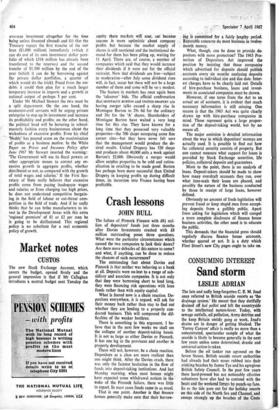Crash lessons
JOHN BULL
The failure of Pinnock Finance with £8} mil- lion of depositors' funds just three months after Davies Investments crashed with £8 million outstanding poses three questions. What were the particular circumstances which caused the two companies to lock their doors? Are there more debacles of this nature to come? and what, if anything, can be done to reduce the chances of such occurrences?
The outstanding fact about Davies and Pinnock is that neither was behaving as a bank at all. Deposits were on-lent to a range of sub- sidiary and associate companies. It is not only that they were borrowing short to lend long, they were financing risk operations with loan funds rather than with equity capitaL What is feared now is a chain reaction. De- positors everyvihere, it is argued, will ask for their money back rather than stay to find out whether they are lending to a properly con- ducted business. This will compound the dif- ficulties of the weaker brethren.
There is something in this argument. I be- lieve that in the next few weeks we shall see the collapse of another deposit-taking house. It is not as large as either Davies or Pinnock. It has one leg in the provinces and another in property development.
There will not, however, be a chain reaction. Depositors as a class are more resilient than one might think. After the Davies crash, there was only the faintest hesitation in the flow of funds into deposit-taking institutions. And last Monday morning, when most houses might have .expected some withdrawal notices in the wake of the Pinnock failure, there was little to report. In most cases funds came in as usual.
That is one point. Another is that finance houses generally make sure that their borrow- ing is committed for a fairly lengthy period. Reputable concerns do most business in twelve- Month money.
What, though, can be done to provide de- positors with more protection? The 1963 Pro- tection of Depositors Act improved the position by insisting that those companies which advertised for deposits should publish -accounts every six months analysing deposits according to individual size and due date. Inter- est charges have to be clearly laid out. Details of hire-purchase business, loans and invest- ments in associated companies must be shown.
However, if one turns from the Act to an actual set of accounts, it is evident that much necessary information is still missing. One reason is that the 1963 Act was quite clearly drawn up with hire-purchase companies in mind. Those represent quite a large propor- tion of the deposit-taking world, but by no means all.
The major omission is detailed information about the way in which depositors' moneys are actually used. It is possible to find out how far collateral security consists of property. But one cannot measure what support for loans is provided by Stock Exchange securities, life policies, collateral deposits and guarantees.
More to the point, there is no analysis of loans. Deposit-takers should be made to show how many overdraft accounts they run, over what time-scale their loans are phased, and possibly the nature of the business conducted by those in receipt of large loans, however defined.
Obviously no amount of fresh legislation will prevent fraud or keep stupid men from accept- ing deposits from a gullible public. Apart from asking for legislation which will compel a more complete disclosure of finance house business activities, the other need is to educate the public.
This demands that the financial press should regularly discuss finance house accounts, whether quoted or not. It is a duty which Fleet Street's new City pages ought to take on.






























 Previous page
Previous page